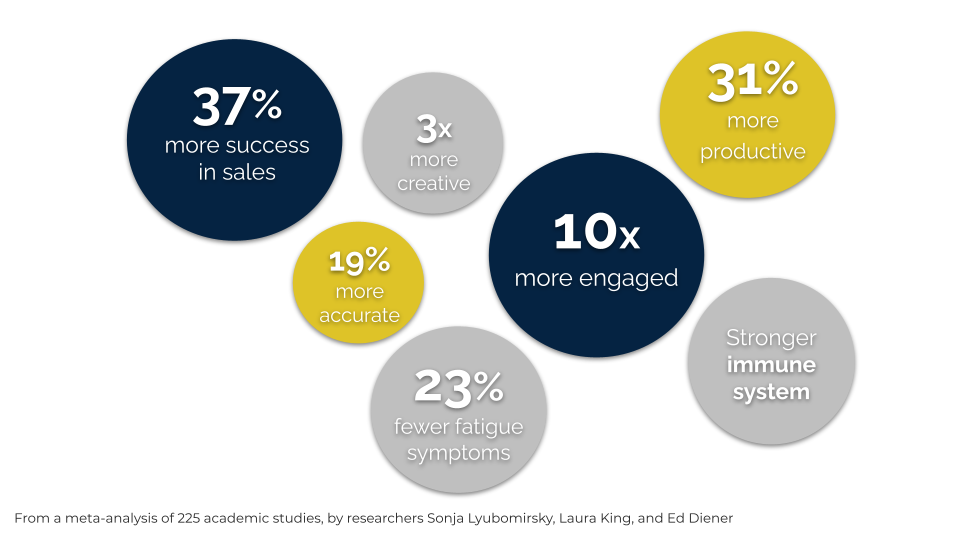30th July, 2024 •

Written by Higson
28th February, 2021 • 4 min

Pursuing happiness and positivity can feel like an abstract quest. How can you just become happier?
Growing research in behavioural science reveals that reflecting on ‘three positive things’ each day can help.
By asking our brain to scan for positive events, feelings, memories, we form a habit of recognising more.
Why is this important? Besides the benefit of feeling happier everyday, there is a strong link between a positive mindset and excellent performance at work. This is called ‘the happiness advantage.’

The ‘three positive things’ is a simple, powerful technique – shared in psychology courses at many of the world’s leading universities – that can help you achieve ‘the happiness advantage’ for yourself or your team.
The evidence speaks for itself. One study asked participants to ‘Write down three things that went well each day and their causes every night for one week.’
Before and after, the Steen Happiness Index measured their happiness levels. After a week, the participants were self-reportedly happier – and it did not stop there. Their happiness levels continued to increase month on month. It was striking that even though the participants only recorded for a week, they continued far beyond because of the benefits they saw.
Numerous studies since have echoed these results. Increased levels of trust in a study run in Japan, improved resilience in healthcare workers and better wellbeing in adults in a UK trial.
Our brains are hardwired to tune into negative events and experiences rather than positive ones. Our ‘negativity bias.’ This has traditionally served us well. For example, imagine we were exploring in the wild. If we hear a roar from a bear, an alarm bell will go off in our brain and we will retreat. Useful – as it is going to protect us from potential attack.
Neuroscientists have found that the amygdala in our brain uses about two-thirds of its neurons to look for potential danger. These events lodge in our memory quickly. Whereas positive events must be held in awareness for longer to transfer into short term memory.
This is why, when we think back to days, events, years – the negative thoughts and feelings can rise to the surface first. When we think back to a pitch or meeting that ‘did not go well at all.’ Our overarching memory is stumbling over our words… Rather than focusing on the way we answered challenging questions and built excellent rapport with the group. This is our negativity bias in action.
Our negativity bias is reinforced by our environment. If we turn on the news the majority of what we see is negative events and information. The odds are stacked against us.
The good news is, the ‘three positive things’ technique helps us to challenge our bias. If we recall three positive events, we redirect our minds. We prime, or train, ourselves to see more positivity. To look at events through a different lens.
As the studies have proved, the longer we practice the technique, the stronger our lens becomes.

1. Where to use it
At the end of the day
Research shows that the most benefit comes from writing down the three positives at the end of each day. The best results come from physically writing, as the language centre is activated and we develop a stronger conceptual understanding.
The technique is also brilliant to use around the dinner table with your family, partner or flatmates.
In a team setting, you can use a digital channel – create a ‘three positives’ channel on slack or teams. The benefits are that you hold each other accountable to write them, communicate key areas of focus for the day to each other and benefit as a group from the happiness advantage.
In the moment
If you find yourself focusing on negatives during the day and having negative self talk – e.g. ‘You fool! All you are doing it making mistake after mistake in this proposal’ (see our blog for more). You can use the technique to redirect your thinking. Pause, and take a moment to write down three things that are going well.
2. What to write
Due to the nature of the negativity bias, sometimes, especially when first getting started, we sit down to write the positives and none come to us. We are thinking… ‘something positive must have happened today?!’ In this situation, here are some questions you can use as a trigger:
Challenge yourself to write three. If you do more than three, brilliant. The theory behind the technique shows that the longer your practice, the easier it becomes.
3. How often
The best results for this are when we do it every day. However, it is important not to worry if you do miss a day or a few days. Recording when possible is much better than not at all.
‘Happiness is not just a place, but also a process..it takes the right attitudes and activities to continue to be happy.’ — Ed Diener, Co-author of Well-Being: Foundations of Hedonic Psychology
We would love to hear from you if you have tried this technique or would like to talk more about its benefits for you or your team.